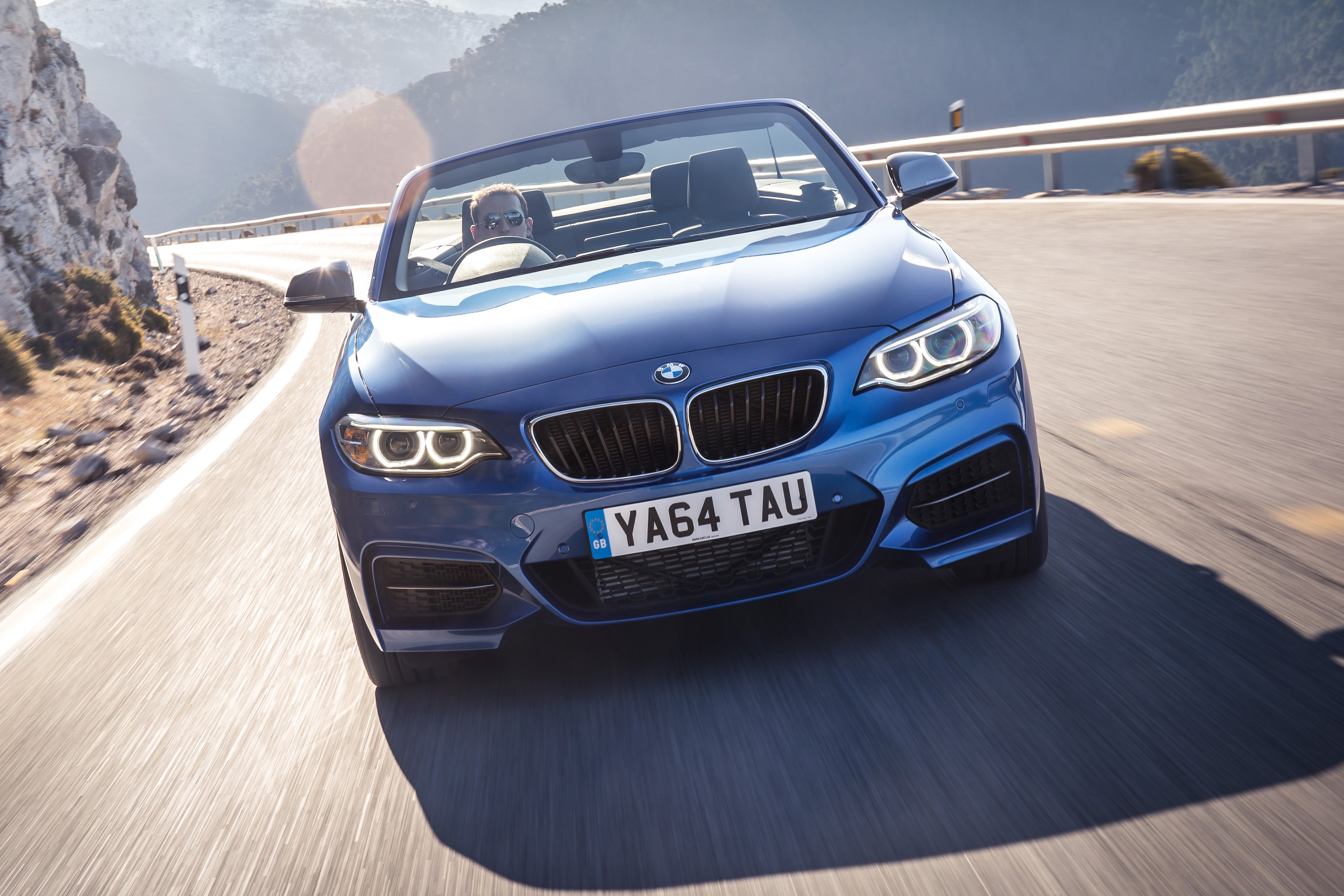BMW 2 Series Convertible (2015-2021) Review
Written by Andrew Brady
Quick overview
Pros
- Truly entertaining to drive
- Stylish convertible looks
- Solid interior with impressive equipment
Cons
- Rear seats are best left to children
- Fabric roof allows some outside noise into the cabin
- Feels dated in places
Verdict: Is the BMW 2 Series Convertible a good car?
"In this BMW 2 Series Convertible review, we're looking at what was once one of BMW's most appealing offerings. When first launched in 2014, it offered accessible, open-top fun."
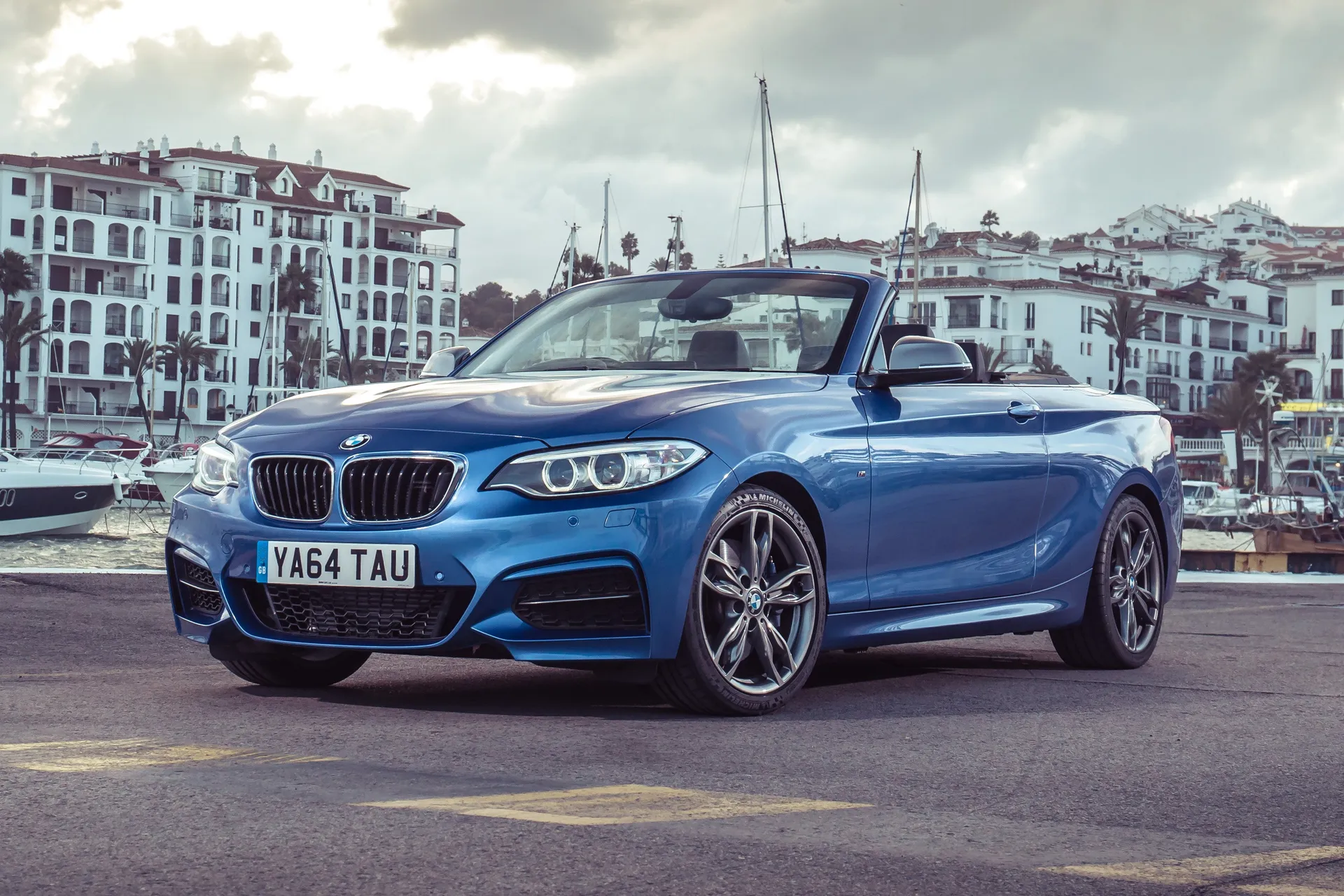
Many people would like to own a small cabriolet like the BMW 2 Series Convertible if they could fit them into their lives. Part of the BMW's big appeal is that it doesn't require too many compromises.
More than 750,000 examples of the BMW 2 Series Convertible and its Coupe cousin were sold, making it a huge success, and it proves how good a job BMW did with its design. It's still one of our favourite convertible cars.
The handsome looks play a part, with sharp lines and neat detailing adding to the appeal. A wide choice of engines, space for four inside (at a push), and that all-important soft-top roof help seal the deal. Throw in the ability to entertain when the roads get twisty, and you can see why so many were sold.
Dropping the BMW 2 Series Convertible's fabric soft-top takes around 20 seconds and can be done on the move at speeds up to 30 mph. It means you can easily take advantage of sunny weather or hide from sudden rain showers. The roof does eat into both boot space and rear headroom, proving that even cars like the 2 Series demand some compromises.
A wide range of engines covered everything from smaller petrol and diesels through true performance machines. The M240i sat at the top of the BMW 2 Series Convertible tree and delivered serious power for those seeking the ultimate driving experience.
The BMW 2 Series Convertible had precise steering, inviting drivers to enjoy their experience behind the wheel. Drivers could choose between a manual or automatic gearbox, the latter suited the 2 Series well. All versions of the Convertible were rear-wheel drive, unlike the Coupe model, which had optional four-wheel drive.
When new, prices for the BMW 2 Series Convertible were relatively high compared to rivals. Offsetting this was a generous level of standard equipment, regardless of trim level. All cars had climate control, DAB radio and parking sensors, plus automatic headlights and windscreen wipers. Higher-grade models added larger alloy wheels and leather seats to the mix.
A mid-life facelift in 2017 saw the 2 Series Convertible gain LED lights, along with a range of new paint colours. A smart-looking digital dashboard was also included in the update.
All versions of the 2 Series had a well-constructed interior. Only some of the trim lower down the dashboard felt plasticky. Almost every driver should get comfortable inside thanks to the adjustment offered. The 2 Series Convertible is a four-seater, but the rear is best left to children. Adults are likely to complain about feeling cramped.
Aside from the limited space in the back, there was lots to like about the 2 Series Convertible. Being fun to drive, it was good to look at, and the option to drop the top had, and still has, plenty of appeal.
Is the BMW 2 Series Convertible right for you?
A small convertible like the BMW 2 Series is all about feeling good behind the wheel. Whether that is from driving enjoyment or the upmarket badge on the bonnet, the BMW 2 Series Convertible still delivers.
Its precise handling, good performance and strong pedigree offered much to like. On the minus side, it was relatively expensive with limited space in the rear and a small boot.
It would happily work as a second car, with the rear seats used for kids or occasional short trips with teenagers. Alternatively, if you’re young, free and single and want to maximise your motoring enjoyment, then a used BMW 2 Series Convertible is a good choice. If you can do without the drop-top element, there's also the standard BMW 2 Series.
What’s the best BMW 2 Series Convertible model/engine to choose?
BMW offered the 2 Series Convertible with an impressive selection of engines, ranging from frugal diesels to powerful petrols. However, the mid-range 220i four-cylinder petrol should still be enough.
It offered sprightly performance while maintaining a balance of fuel economy and affordability. We recommend the 220i with the automatic gearbox. It suits the laid-back, convertible mood, and the manual is not quite so nice to use.
Should you drive major miles, particularly on motorways, the diesel 225d offers even better economy.
The BMW 2 Series Convertible had various expensive options. As such, shoot for the high-level M Sport version. It looks sporty and has bigger alloy wheels, sports seats and fancier interior trim.
What other cars are similar to the BMW 2 Series Convertible?
Audi’s A3 Cabriolet was closest in spirit and size, with a comparable premium badge and smart styling.
It wasn't quite as good to drive as the 2 Series Convertible and could become expensive with options. However, its rear seats offered slightly more legroom, and its boot was fractionally larger. Like the BMW, the Audi has since been discontinued.
The MINI Convertible is a smaller and more affordable soft-top option. Space is limited, though, with the boot that’s very small indeed. It is still fun to drive, however. Another modern alternative is the Volkswagen T-Roc Cabriolet. At a higher price point is the Mercedes-Benz CLE.
Comfort and design: BMW 2 Series Convertible interior
"The BMW 2 Series Convertible carries a premium price tag, but fortunately its interior does not disappoint. It will be very familiar to anyone who has spent time inside a modern BMW, with a high degree of quality and finish."
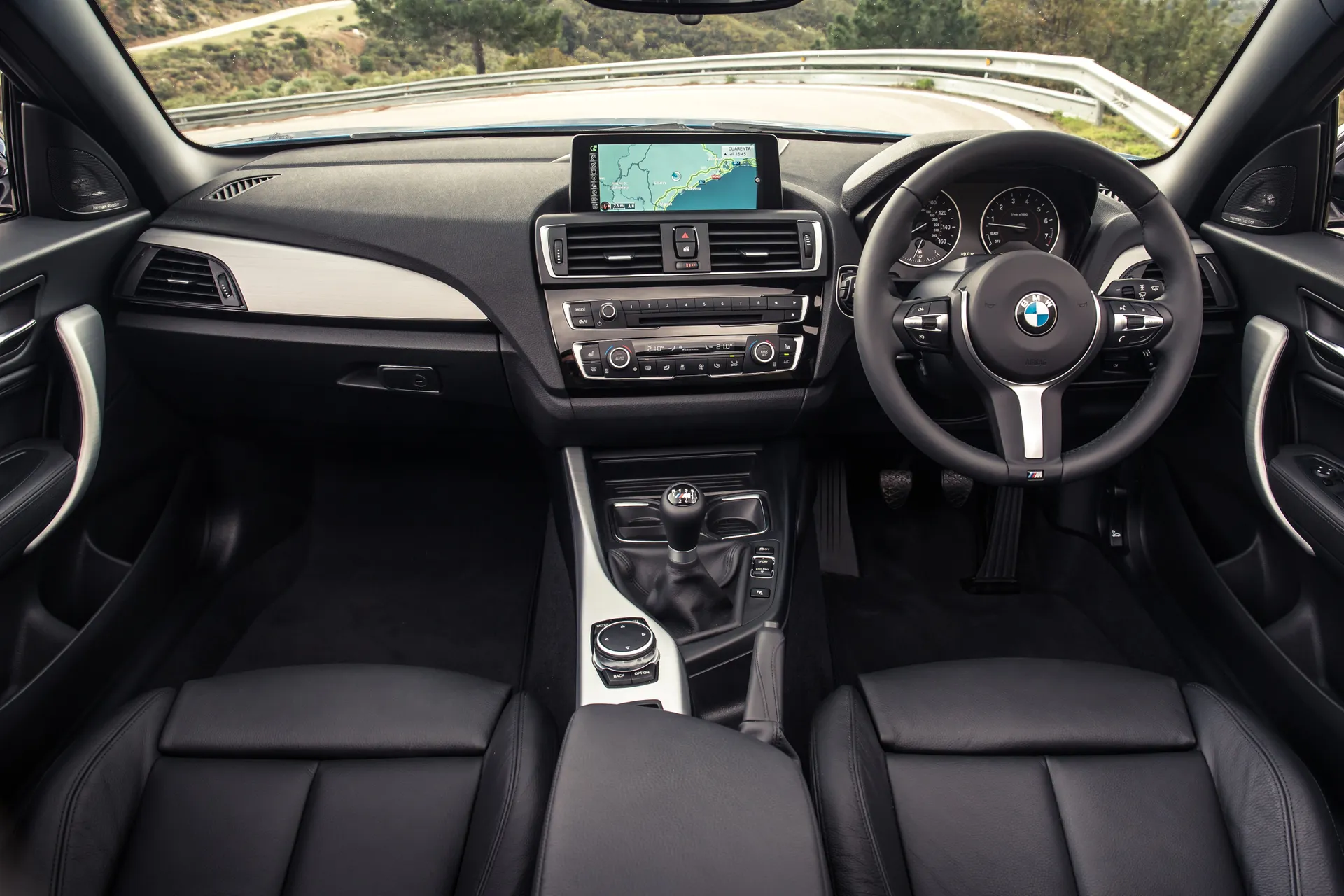
In terms of driving position, those used to SUVs may be surprised at how low to the ground they sit inside the BMW 2 Series Convertible. This is all part of the sporty appeal, allowing drivers to feel close to the action. The dashboard's angle towards the driver is a classic BMW touch, making the controls easier to reach.
Cars equipped with manual transmissions suffer from offset pedals. It’s a relatively minor gripe, but it is another reason to consider the excellent automatic gearbox instead.
All drivers should get comfortable inside the BMW 2 Series Convertible. The standard front seats offer excellent support and comfort. Sport and M Sport models benefit from grippier sports seats, while electric seat adjustment is found on top-spec versions.
Those in the rear will be less comfortable unless they are children. Legroom is restricted for all, and the soft-top roof eats into headroom when up. If the optional wind deflector's fitted, this reduces buffeting with the roof down but renders the back seats unusable.
Quality and finish
BMW 2 Series Convertible buyers will (rightly) expect a high-quality and well-finished interior. The 2 Series looks like it is built to last – and does so in style.
The overall impression is still quality, even if some of the plastics lower in the cabin are a little flimsy. However, these are small items inside a car that won’t leave buyers feeling shortchanged.
Entry-level BMW 2 Series Convertible SE specification cars had satin silver interior detailing throughout the cabin. This changed to gloss black on Sport specification models and aluminium with a hexagon design on M Sport cars. Rare Luxury models often had wood trim inside, although this was optional across the range.
Luxury cars also had standard Dakota leather seats. Other versions had cloth upholstery, while the sporty M235i and M240i had cloth and Alcantara seats. All cars featured a leather-wrapped steering wheel as standard.
Infotainment: Touchscreen, USB, sat-nav and stereo in the BMW 2 Series Convertible
BMW began developing modern multimedia systems nearly two decades ago and has become a master at the art. The iDrive controller and display fitted to all 2 Series Convertible models is still fast and easy to use.
A 6.5-inch multimedia screen sat high on the dashboard and was used to control an array of functions. Radio and phone connectivity, and navigation were all accessed through the screen. Setting changes were done via the rotary iDrive controller on the centre console. Buttons on the steering wheel could be used, too.
Later versions of the BMW 2 Series Convertible, following the facelift in 2017, gained an 8.8-inch display. On cars specified with the optional Professional Multimedia package, this became a touchscreen for added ease of use.
All cars were fitted with a single CD player, USB ports, and Bluetooth connectivity for mobile phone use and audio streaming. Apple CarPlay was a cost option back then. BMW also offered a range of upgrades, such as a Harman Kardon sound system.
The M240i's highlight was its standard black panel display for the instrument cluster. This replaced the traditional gauges with a digital dashboard, allowing extra information to be shown to the driver.
Space and practicality: BMW 2 Series Convertible boot space
The BMW 2 Series Convertible dimensions are 4.4m long and 1.9m wide, and it was one of the most compact convertibles of its era.
BMW claimed the 2 Series Convertible was a four-seater, but the reality was slightly different. Those rear seats were best reserved for children as they provided limited legroom. On the plus side, BMW fitted the rear bench with ISOFIX attachments for child car seats.
The roof also ate into headroom when raised, meaning adults could find themselves unceremoniously wedged against the fabric top.
Up front, both driver and passenger had more than enough room. BMW’s ‘boat deck’ interior design made the doors feel quite high, adding a sense of being cocooned inside the car. Despite this, the 2 Series avoided claustrophobia and added to the overall feeling of sportiness.
The compact dimensions of the BMW 2 Series Convertible came to the fore when discussing boot space. As with many convertibles, lowering the roof eats into room for luggage inside the boot. This means the 2 Series goes from having 335 litres of boot space to a more measly 220 litres.
This is equivalent to swapping the boot in a regular family hatchback for one in a small city car instead. Adding to this is the saloon-style boot opening that the 2 Series has. Fitting larger items into the boot becomes a battle, and throwing items onto the rear seats might become the more attractive option.
BMW offered an optional ski-hatch opening between the rear seats, allowing longer loads to be slotted through into the cabin.
Limited boot space means no spare wheel. Instead, BMW installed run-flat tyres. These allowed the driver to keep going at a reduced speed to reach a garage.
Handling and ride quality: What is the BMW 2 Series Convertible like to drive?
"How the BMW 2 Series Convertible drives is one of the standout features of this compact drop-top. Unlike some rivals, the 2 Series actually has the ability to live up to its sporting looks – and offer real entertainment for keen drivers."
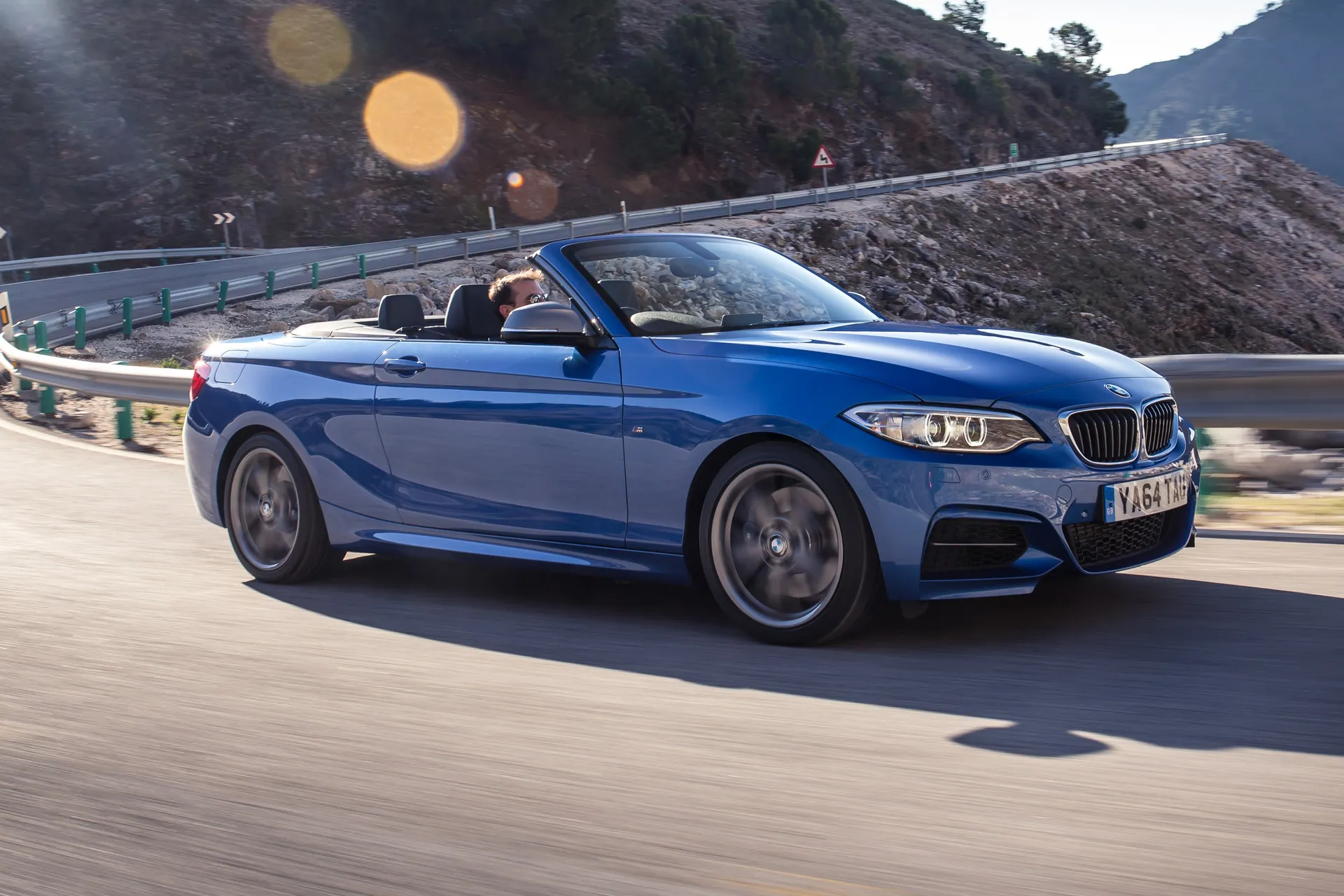
The steering of the 2 Series is precise and well-weighted, meaning it'll thread through curves. Around town, the car slots into parking spaces and holds its line confidently on motorways.
BMW offered Variable Sport Steering across the 2 Series range as an option. This provided lighter steering when parking and meant less effort was needed to negotiate turns at speed. It was an acquired taste when released, so test-driving a car with this fitted is a must.
Given its sporting intent, it should be no surprise that the ride in the BMW 2 Series Convertible is on the firm side. Standard SE models make the smoothest progress, with 17-inch alloy wheels and comfort-orientated suspension. Luxury trim cars had 18-inch wheels, giving a slightly harder feel.
Sport and M Sport cars featured sports suspension as standard. Sport models had 17-inch wheels, with 18-inch items fitted to the M Sport. This suspension did make the ride firmer, but never to the point of being uncomfortable.
BMW liked to give buyers suspension options on the 2 Series. SE and Luxury versions had firmer sports suspension added. Conversely, it could also be deleted from Sport and M Sport models.
There was also the option to have Adaptive M Sport suspension on all versions. This lowered the car by 10mm and allowed drivers to choose between Sport and Comfort suspension settings at the flick of a switch.
What engines and gearboxes are available in the BMW 2 Series Convertible?
BMW offered the 2 Series Convertible with various engines: four petrol and three diesels, and performance is ‘warm’ to ‘very hot’.
Petrol engines started with the 218i. Ignore the badging, as this was a 1.5-litre, three-cylinder unit. Producing 136 PS, it served up relatively mild acceleration but without major savings in fuel economy compared to the other petrol choices.
The four-cylinder 184 PS 2.0-litre 220i offered more go. Zero to 62 mph took 7.7 seconds, which should be enough for most. The 228i and 230i versions used a similar four-cylinder engine with up to 252 PS but were no worse for fuel economy.
Topping the range was the M240i. Originally badged as the M235i, revisions in 2016 saw it rebranded. It used a turbocharged six-cylinder engine, producing a considerable 326 PS in M235i guise. The M240i took this up to 340 PS. It was a serious engine for those who wanted the most performance.
Diesels were essentially the same 2.0-litre four-cylinder turbocharged unit but offered in different states of tune. Things began with the 184 PS 218d, rising to the 190 PS 220d. The range was topped by the 225d, which made a hefty 224 PS.
The standard six-speed manual gearbox had a short, precise shift, but its offset pedals hampered some enjoyment. BMW’s eight-speed automatic transmission was superb, though. Unless you are firmly set on a manual, we'd still recommend the auto ’box.
Refinement and noise levels
A car with a fabric soft-top will always struggle to provide the same level of refinement as one with a solid metal roof.
BMW tried hard with the 2 Series Convertible, honing its aerodynamics and ensuring the roof sealed tightly. With the roof up, noise from the wind and road was well contained and not hugely different to the Coupe model.
Dropping the roof made a difference, of course. Without the optional wind deflector, be prepared for things to get a little blustery. Although it takes up rear-seat space, the deflector is worthwhile for calm motoring.
The petrol range was generally pleasant and quiet. Those going for the M235i or M240i will certainly enjoy the sound from the exhaust tailpipes, too. Diesel models were a little rowdier, sending more vibrations back into the cabin when pushed.
Overall, none of the issues noted above are likely to be a deal-breaker when considering the BMW 2 Series Convertible.
Safety equipment: How safe is the BMW 2 Series Convertible?
BMW never submitted the 2 Series Convertible for crash testing by Euro NCAP. But, the 1 Series hatchback (which the 2 Series shares a platform with) was tested. That scored the maximum five stars when new, so it seems fair to assume the 2 Series would perform well. Likewise, the 2022 2 Series Coupe scored four stars.
A total of six airbags were fitted as standard to the BMW 2 Series Convertible, plus a pop-up bonnet to protect pedestrians during a collision. Roll bars automatically deployed from behind the rear seats should the car sense it was beginning to flip over.
Dynamic Stability Control was fitted on all 2 Series models, along with traction control. M Sport models also had the option of the upgraded M Sport braking system, bringing stronger stopping power.
All models benefit from rear parking sensors as standard. Visibility was restricted with the soft-top raised, so these were useful. Front sensors could be added as an upgrade, with a rear-view reversing camera also on the options list.
Models sold after the 2017 facelift benefited from extremely bright LED headlights across the range. LED daytime running lights plus LED taillights were also fitted to facelifted cars. Due to larger air intakes, M Sport models went without the LED fog lights.
MPG and fuel costs: What does a BMW 2 Series Convertible cost to run?
"For a car with sporty intentions, BMW has endowed almost all versions of the 2 Series Convertible with respectable fuel economy. "
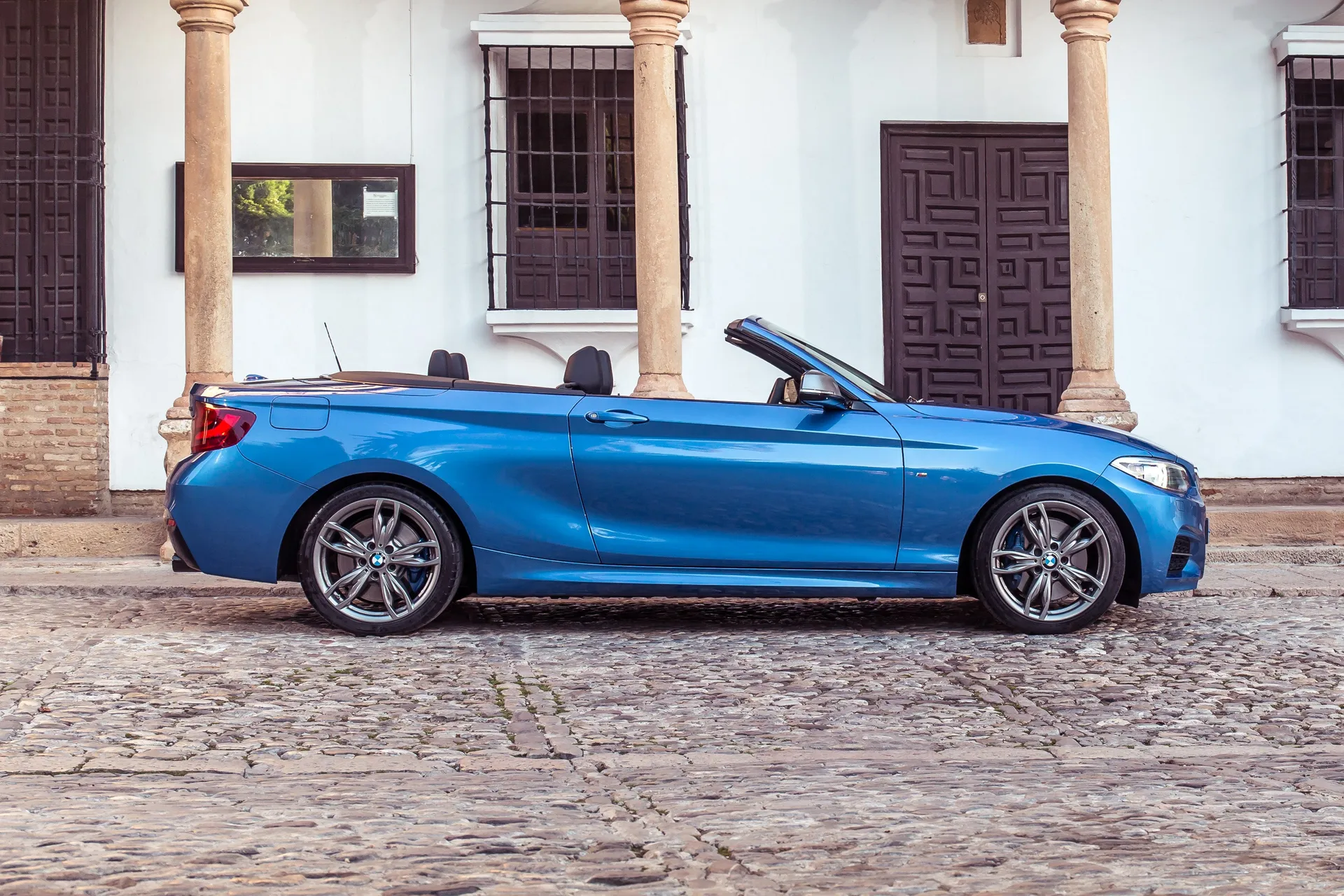
The diesel models offered the best overall efficiency, especially with the optional eight-speed automatic gearbox. Both the 218d and 220d achieved 58.9 mpg with the auto ‘box in official WLTP tests, with even the more powerful 225d returning 56.5 mpg.
The mid-range 220i petrol sips the least fuel, at 44.1 mpg, with a manual gearbox. The auto version upped this to 45.6 mpg and was matched by the 230i model.
Given the power and performance offered, the M235i and M240i returned respectable economy. The later, more powerful M240i managed 37.2 mpg with the automatic gearbox.
BMW 2 Series Convertible reliability and warranty
Including the Coupe in the responses, the BMW 2 Series Convertible scored a highly impressive 9.74 out of 10 in the HonestJohn.co.uk Satisfaction Index, making it one of the best-performing BMWs of its era.
Although the 2 Series Convertible hasn't scored on recent HonestJohn lists, BMW scored 12 out of 29 manufacturers in the latest Satisfaction Index.
BMW 2 Series Convertible insurance groups and costs
A premium badge, sporty looks and powerful engines mean the BMW 2 Series Convertible isn't the cheapest car to insure.
The entry-level 218i SE is the most affordable at group 22, while Sport and M Sport models increase this to group 23. The mid-range 220i is group 29 in Sport trim, or 30 for the M Sport version. Predictably, the M240i is the highest of all, with a group 42 rating. This rises to 46 in 07/17 onward cars.
Diesels begin at group 24 for the 218d, increasing to 29 for the 220d, and 32 for the 225d.
VED car tax: What is the annual road tax on a BMW 2 Series Convertible?
If keeping costs low is important, picking the correct engine is vital. Cheap tax starts with the 218d, although it's worth checking how much CO2 your car emits. One 218d can emit 118g/km while another, 124 g/km. Getting this wrong means a £125 tax difference.
Cars registered on or after 1 April 2017 can cost significantly more. For example, a 218d from 07/17 onwards can emit anywhere between 122 to 159g/km, meaning different tax bands. At 159g/km, new tax regulations will mean an initial £680 first-year payment, dropping to £190 afterwards.
As expected, range-topping M240i cars cost significantly more as these emit between 169 and 204 g/km. Simply put, the higher figure means a £1,650 first-year payment, although this drops back to the standard £190 afterward.
BMW 2 Series Convertible price
"Prices for 2021 cars range from £17,000 to £22,000. Earlier 2016 cars can be had from as little as £6,300."

The cheaper, earlier cars have sub-100,000 miles and are mostly 218d and 220d models. There are a few 220i and 218i cars, however.
At the opposite end is the M240i, ranging between £17,000 and £22,000. Coupes are slightly cheaper, starting from £4,250 for 218d and 220d models.
Trim levels and standard equipment
BMW was quite generous with the 2 Series Convertible, giving all trim levels impressive amounts of standard equipment.
BMW 2 Series Convertible SE cars had 17-inch wheels, a single chrome exhaust tailpipe, automatic air conditioning and a 6.5-inch iDrive multimedia screen. Automatic headlights and windscreen wipers were also standard fit, as were cloth seats.
BMW 2 Series Convertible Luxury models are rare, having only been sold until February 2016. These had 18-inch wheels and seats finished in Dakota leather.
BMW 2 Series Convertible Sport versions gained sports seats, sports suspension, and minor changes to bodywork. Cloth upholstery was still used, with gloss black trim found on the dashboard and centre console.
Moving on up to BMW 2 Series Convertible M Sport models delivered 18-inch alloy wheels, sportier bumpers and M Sport suspension. The interior featured part-Alcantara seat trim. Opting for the M235i or M240i meant standard leather seats, special mirror caps, upgraded brakes and Variable Sport Steering.
We would be inclined to seek out BMW 2 Series Convertible M Sport models. These include a larger range of equipment that suits the nature of the 2 Series Convertible. M Sport cars rarely cost much more than other versions.
Ask the heycar experts: common questions
Does BMW still make a 2 Series Convertible?
Is the BMW 2 Series Convertible reliable?
How much is a BMW 2 Series Convertible?
Get our latest advice, news and offers
Keep me updated by email with the latest advice, news and offers from heycar.
By submitting you agree to our privacy policy
